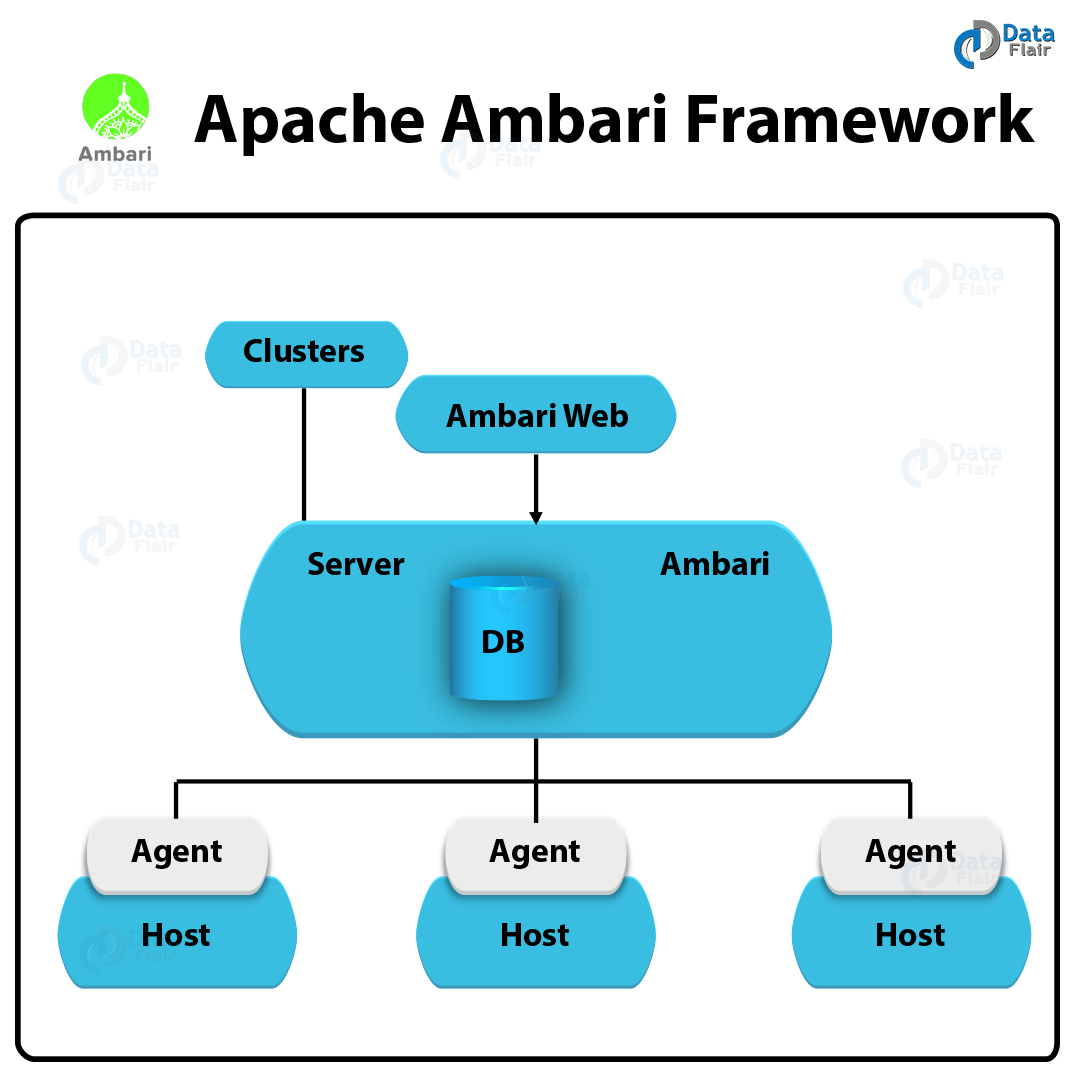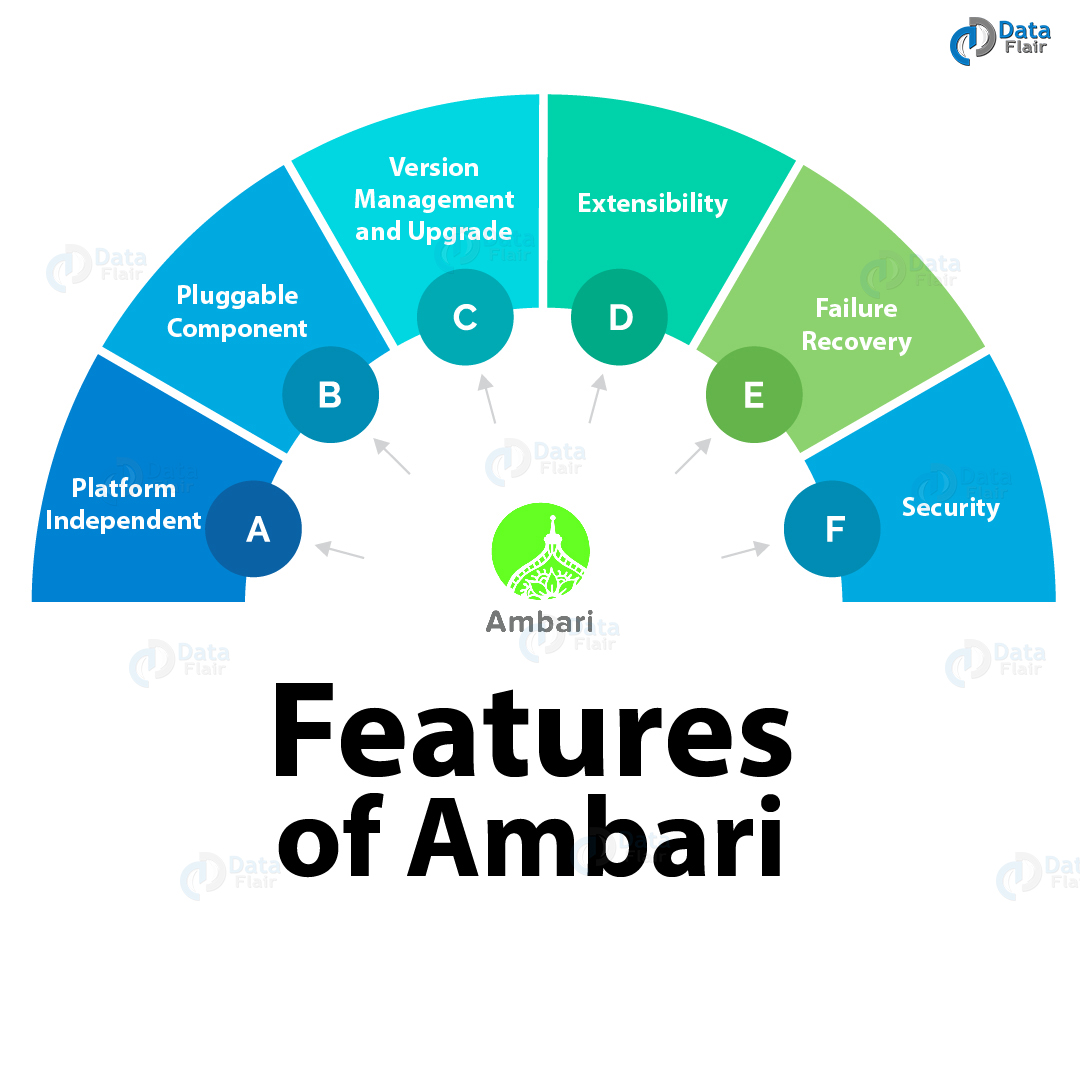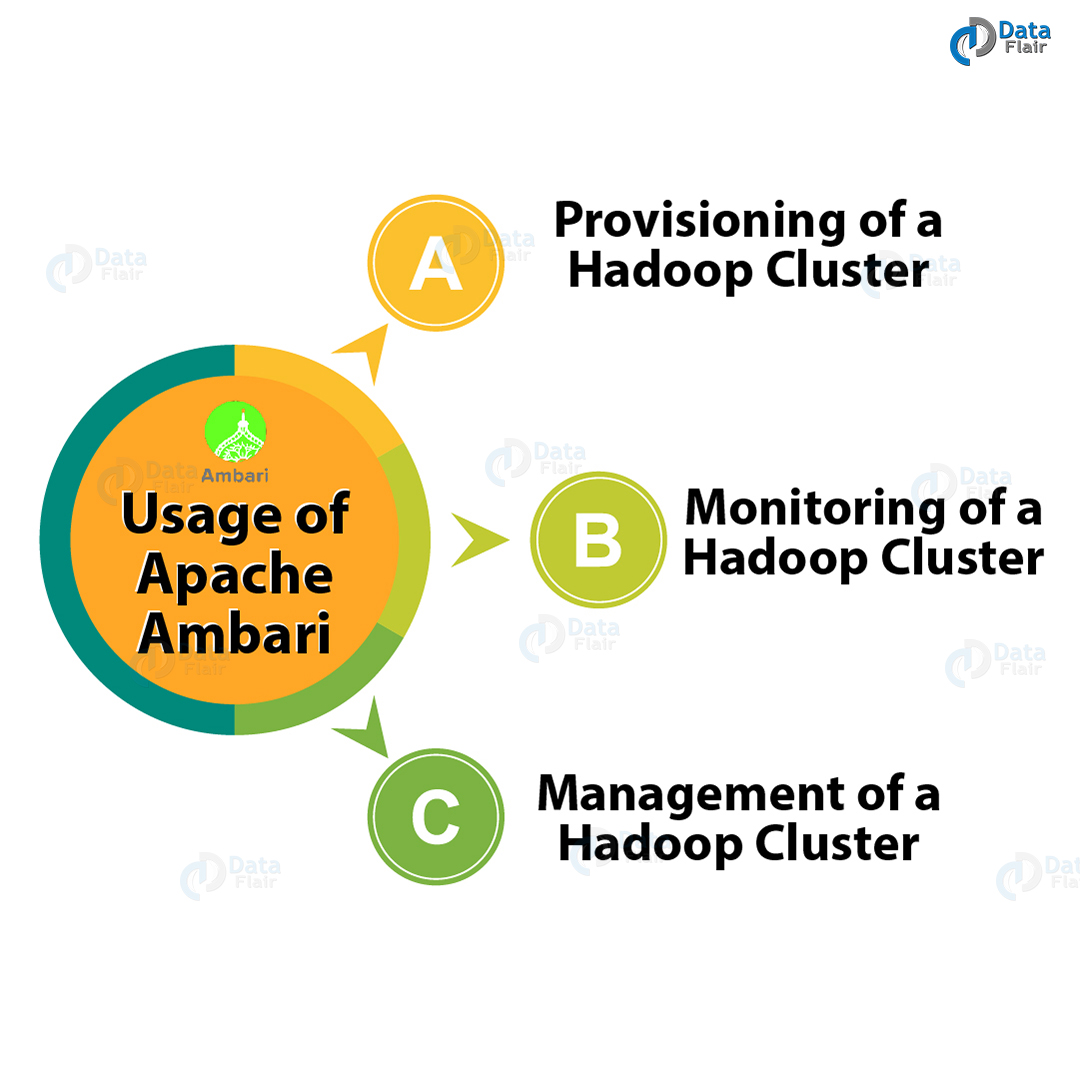Ambari Tutorial For Beginners | Learn Apache Ambari
FREE Online Courses: Transform Your Career – Enroll for Free!
Today, we will start our new journey with Apache Ambari Tutorial. In this Ambari tutorial, we will learn the whole concept of Apache Ambari in detail. Apart from its brief introduction, we will discuss Ambari architecture, features, and benefits as well.
Also, we will see Apache Ambari uses to get in-depth information on it. Moreover, we will discuss how it beneficial in comparing with Apache Zookeeper to understand well.
Basically, Ambari is a tool which is responsible for keeping track of running applications and their status. Though, there is much more to learn about Ambari in detail.
So, let’s start Apache Ambari Tutorial.
What is Apache Ambari?
An open source administration tool which is responsible for keeping track of running applications and their status is what we call Apache Ambari.
Basically, it is deployed on top of the Hadoop cluster. Moreover, we can consider it as an open source web-based management tool which manages, monitors as well as provisions the health of Hadoop clusters.
However, to visualize the progress as well as the status of every application which is running over the Hadoop cluster, Ambari offers highly interactive dashboard which permits administrators.
In addition, it is very flexible and scalable user-interface which permits a range of tools, for example, Pig, MapReduce, Hive, and many more to be installed on the cluster and administers their performances in a user-friendly fashion.
Here in Ambari Tutorial, some key points of this technology are:
- Instantaneous insight into the health of Hadoop cluster using pre-configured operational metrics.
- Also, it is very easy to perform installation due to its user-friendly configuration.
- Basically, through the Hortonworks data platform, we can easily install Apache Ambari.
- Moreover, by visualizing and analyzing jobs and tasks, dependencies and performances monitored here.
- By installing Kerberos-based Hadoop clusters, Authentication, authorization, and auditing takes place.
- Since it is very flexible and adaptive technology, it is fitting perfectly in the enterprise environment.
Ambari Tutorial – History of Ambari
When Hadoop’s distributed and scalable computing took the world by storm, the genesis of Apache Ambari traces the emergence of it.
As there were multiple technologies incorporated that became difficult for the cluster to maintain multiple nodes as well as applications at the same time. So, in order to make distributed, computing easier Ambari came into the picture.
Nowadays, under Apache Software Foundation, Ambari is one of the leading projects running.
Ambari Tutorial – Audience
Those aspirants who want to work as following profiles can definitely go for Apache Ambari:
- Hadoop administrators
- Database professionals
- Mainframe and Hadoop testing professionals
- DevOps Professionals
Why Should You Learn Apache Ambari?
Basically, a project which targets to make management of Hadoop easier and simpler for the developers and administrators is Apache Ambari.
Also, by developing required software for management, monitoring, and provision of Apache Hadoop clusters, Ambari permits system administrators to manage Hadoop clusters and ecosystem effectively.
In addition, it makes easier to use web-based UI with RESTful APIs for Hadoop management. Hence we can say due to the various advantages it offers, engineers and administrators are now trying to get their hands on Apache Ambari.
Here are some specific reasons why we should aim to learn Apache Ambari:
- Administrative Management Capabilities
- Simple to Use and Learn
- Career Opportunities
- Lifecycle Management
a. Administrative Management Capabilities
In order to efficiently manage the entire Hadoop ecosystem, Apache Ambari offers excellent management abilities to the developers and administrators, such as:
- Removing or adding hosts to the cluster.
- Start, stop, add, remove or restart the services.
- After configuration changes, restarting the clusters or services.
- Also, it allows rollback, edits the service/components configurations.
- It helps to move the nodes to a different host.
b. Simple to Use and Learn
It becomes easy for us to learn Apache Ambari with its web easy interface. We can say its main purpose is to offer an easier way to manage and monitor Hadoop ecosystem. Even without any user interaction, Ambari APIs are made to perform the cluster automation.
In addition, we can pick and choose the hosts we require the cluster use along with the services need to be installed, by using Ambari.
c. Career Opportunities
In the last couple of years, there is a huge demand for professionals those are carrying Apache Ambari skills. Hence there hiring has also increased a lot. The Hadoop professionals with Ambari skills are receiving significant growth (approximately 12%) in the average salary nowadays.
Though, in the coming years, this requirement will only increase. As scenarios we can say, in this field, there are huge career growth and progression opportunities.
d. Lifecycle Management
To manage the services in the Hadoop ecosystem, Ambari follows lifecycle management format which permits it. Thus commands like install, configure, status, start and stop being used to work with the services and also it offers the flexibility of configuration as well.
Ambari Architecture
Now, in Ambari Tutorial, basically, to automate the operations in the Hadoop cluster, Ambari offers intuitive and REST APIs. It is fairly efficient in operational control, because of it’s consistent as well as the secure interface. Moreover, by using an interactive dashboard, it’s easy and user-friendly interface efficiently diagnoses the health of Hadoop cluster.
As you can see, its architecture consists of two major components they are Ambari Server and Ambari Agent. On defining both:
- An authoritative process which communicates with the agents which are installed on each node on the cluster is Ambari server. However, there is an instance of Postgres database which handles all the metadata here.
- Whereas, the active member which sends the health status of every node along with diverse operational metrics, are Ambari agents.
Afterward, followed by the agents, the next course of action is decided by the mater process only. Thus, Ambari is quite handy and comes with a step-by-step guide allowing easy installation on the Hadoop cluster, it is most preferred by the big data developers.
Moreover, by incorporating Kerberos and Apache Ranger into the architecture, Ambari sets up a centralized security system. And, the RESTful APIs integrates the operational tools and also monitors the information.
In addition, it is in the range of the top ten open source technologies for Hadoop cluster due to its user-friendliness and interactivity.
How is recovery achieved in Ambari?
In two possible ways, recovery happens in Ambari, such as:
i. Based on actions
In Ambari after a restart master checks for pending actions and reschedules them since every action is persisted here. Also, the master rebuilds the state machines when there is a restart, as the cluster state is persisted in the database. While actions complete master actually crash before recording their completion, when there is a race condition.
Well, the actions should be idempotent this is a special consideration taken. And, those actions which have not marked as complete or have failed in the DB, the master restarts them. We can see these persisted actions in Redo Logs.
ii. Based on the desired state
While there is a restart the master tries to make the cluster in the live state as per the desired state as the desired state of the cluster is persisted by the master.
Ambari Tutorial – Features of Ambari
Now it’s time to learn that what are the reasons that Ambari stands out of crowd and so popular. So, here is the list of best features which make it’s so popular among all:
a. Platform independent
Apache Ambari architecturally supports any hardware and software systems that’s why it runs in Windows, Mac and many other platforms. Apart from them, Ubuntu, SLES, RHEL etc are platforms where Ambari runs.
b. Pluggable component
It is possible to customize any current Ambari application. Basically, by pluggable components, any specific tools and technologies ought to be encapsulated. Although, we can say it does not hold the standardization of inter-component.
c. Version management and upgrade
There is no need of external tools like Git since Ambari itself maintains versions. It is quite easy if we need to upgrade any Ambari application or even Ambari.
d. Extensibility
By adding different view components, we can extend the functionality of existing Ambari applications.
e. Failure recovery
Ambari application supports failure recovery well.
f. Security
The Ambari application can sync with LDAP over the active directory, that says it comes with robust security.
Apache Ambari Tutorial – Benefits
There are several benefits, Ambari offers:
- Installation, configuration, and management is way simplified.
- Centralized security and application.
- Complete visibility to cluster health.
- Metrics visualization and dashboarding.
- Extensibility and customization
Ambari Usage
As we know, to manage Hadoop using web UI and providing different services to the System Administrators, Apache Ambari is an intuitive way.
Besides that, it helps to simply accessing and managing complex and large distributed systems of Hadoop. And, Ambari supports many components. For Example Hive, Pig, MapReduce, HBase, HDFS, and many more.
- Provisioning of a Hadoop Cluster
For any number of hosts, we can install service as it offers a step by step process for the Hadoop services.
- Monitoring of a Hadoop Cluster
In a holistic way, Ambari monitors the Hadoop cluster. It is possible to monitor the status and health of Hadoop clusters effectively through the dashboard.
- Management of a Hadoop Cluster
Basically, to manage the services of Hadoop in the clusters, Apache Ambari offers a central platform. It is also responsible for the start, stop, and configuration of the services among all the clusters.
In order to integrate the Hadoop management, monitoring capabilities, and provisioning of the clusters with Ambari REST APIs, Ambari permits the system integrators and application developers.
Ambari vs ZooKeeper
It is one of the misconceptions that Zookeeper and Ambari perform similar kind of tasks. Although, there is some difference between them, such as:
a. Basic Task
i. Apache Ambari
The basic task of Ambari is to perform monitoring, provisioning and managing Hadoop cluster
ii. Apache ZooKeeper
On the other hand, Zookeeper maintains configuration information as well as naming and synchronizing of the cluster.
b. Nature
i. Apache Ambari
The Web interface
ii.Apache Zookeeper
The Open-source server.
c. Status maintenance
i. Apache Ambari
In Ambari, APIs maintains status.
ii. Apache Zookeeper
On the other hand, ZNodes maintains status.
Scope in Ambari
Among the existing big data technologies, Ambari has seen tremendous growth over the last year gaining immense popularity.
Basically, for many years, to manage their huge clusters in a better fashion, bigger companies are increasingly turning towards this technology that made it spiral upwards in the technology pecking order. It is a saying that there is much more to come in this technology in the near future for sure.
Ambari Career Opportunities
As we know big data and analytics are becoming very popular nowadays so to grab the lucrative career opportunities in this area those professionals who have a good grasp of Ambari or the related technologies have the greater possibility to get career growth.
Hence, for building a career, learning Ambari will certainly be a good choice. It will be a token of success if anyone will have knowledge of the proper technology in the coming years.
So, this was all in Ambari Tutorial. Hope you like our explanation of Apache Ambari.
Conclusion: Ambari Tutorial
Hence, in this Ambari tutorial, we have seen the whole about Apache Ambari in detail. Moreover, we discussed Ambari Career Scope and Future Opportunities. Also, we saw the benefits, features, and architecture of Ambari.
However, there is much more to learn about Apache Ambari. So, keep visiting Data Flair, for more articles on Ambari. Still, if any doubt regarding Apache Ambari Tutorial, ask in the comment tab.
Your opinion matters
Please write your valuable feedback about DataFlair on Google





